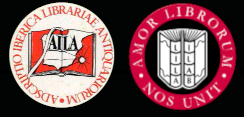


Home |
Temáticas |
Catálogos |
Pedidos |
  |  |
|||||||
|

|
RUGENDAS. (Johann Moritz) HABITANTE DE GOYAS, QUADRO A ÓLEO PINTADO SOBRE MADEIRA. |
|
|
Clique nas imagens para aumentar. TARRAGO Y MATEOS. (Torcuato) O MONGE NEGRO.Romance Historico por D. Torcuato Tarrago y Mateos. Traduccão Livre de Julio Baptista. Typographia Elvense. Elvas. 1860. De 21,5x15 cm. Com 725, vii, [ii] págs. Encadernação da época com lombada em pele, com ferros a ouro. Ilustrado em extratexto com 13 litografias e um frontispício a preto e branco sobre papel mais encorpado. Exemplar com ex-libris xilográfico na guarda anterior. A última folha, com nota do tradutor, tem um rasgo sem falha de texto. Inclui no frontispício o subtítulo: «O Monge Negro ou A Fome de Madrid». A 1.ª Edição espanhola foi publicada em Madrid por Miguel Prats, editor, [s.a. 1857] (imprensa de C. González), a segunda no mesmo ano - Madrid por Prats, editor, 1857 (Imprensa de J. Casas y Díaz) e depois foi publicada uma terceira em 1860. Esta tradução portuguesa livre caracteriza-se por incluir citações de Herculano em epígrafe de alguns capítulos e ilustra as estreitas relações entre Portugal e Espanha assim como a grande actualização em relação às novidades literárias do país vizinho. É também importante para o estudo da tipografia e da vida literária em Elvas. Este romance histórico decorre durante a Guerra Peninsular, ou seja, entre 1807 e 1814, e descreve alguns dos seus principais episódios, como, por exemplo, a Batalha de Salamanca. Divide-se em três partes: O Conde de Malvar; A Fome de Madrid; A Vingança de um Cadáver. Torcuato Tárrago y Mateos (Granada, 1822 – Madrid, 1889) foi um militar, jornalista, escritor e músico espanhol. Iniciou a sua carreira como subtenente do Exército espanhol, mas as suas convicções políticas mudaram ao longo do tempo, tornando-se um carlista convicto após promover o levantamento de 1869, enfrentando perseguições durante a Revolução Cantonal. Destacou-se como colaborador em vários jornais, expressando as suas convicções políticas e apoiando causas que considerava justas. O seu interesse pela escrita resultou numa variedade de obras, incluindo 'História de um chapéu branco' e 'A doze mil pés de altura'. Influenciado por Júlio Verne, explorou temas relacionados ao mundo eslavo e foi pioneiro ao escrever sobre a guerra de independência da Bulgária. Foi um dos quatro pilares que sustentaram o romance histórico espanhol em meados do século XIX, juntamente com Fernández y González, Ortega y Frías e Pérez Escrich. A sua vida multifacetada reflete uma figura ativa na sociedade espanhola da sua época.
Copy with woodcut ex-libris on the front pastedown. The last leaf, with the translator's note, has a tear with no loss in the text. The frontispiece includes the subtitle: «O Monge Negro ou A Fome de Madrid» (The Black Monk or The Hunger of Madrid). The 1st Spanish Edition was published in Madrid by Miguel Prats, editor, [s.a. 1857] (press of C. González), the second in the same year - Madrid by Prats, editor, 1857 (Press of J. Casas y Díaz) and then a third was published in 1860. This Portuguese free translation is characterised by the fact that it includes quotations from Herculano in the epigraphs of some chapters and illustrates the close relationship between Portugal and Spain as well as the fact that it is very up-to-date with literary novelties in the neighbouring country. It is also important for the study of typography and literary life in Elvas. This historical novel takes place during the Peninsular War, between 1807 and 1814, and describes some of its main episodes, such as the Battle of Salamanca. It is divided into three parts: O Conde de Malvar (The Count of Malvar); A Fome de Madrid (The Famine of Madrid); A Vingança de um Cadáver (The Revenge of a Corpse). Torcuato Tárrago y Mateos (Granada, 1822 - Madrid, 1889) was a Spanish military officer, journalist, writer and musician. He began his career as a sub-lieutenant in the Spanish Army, but his political convictions changed over time, becoming a staunch Carlist after promoting the uprising of 1869, facing persecution during the Cantonal Rebellion. He stood out as a contributor to various newspapers, expressing his political convictions and supporting causes he considered just. His interest in writing resulted in a variety of works, including 'História de um chapéu branco' ('Story of a White Hat') and 'A doze mil pés de altura' ('Twelve Thousand Feet High'). Influenced by Jules Verne, he explored themes related to the Slavic world and was a pioneer in writing about Bulgaria's war of independence. He was one of the four pillars that sustained the Spanish historical novel in the mid-19th century, along with Fernández y González, Ortega y Frías and Pérez Escrich. His multi-faceted life reflects an active figure in the Spanish society of his time. Referência: 2403SB006
Local: M-3-B-67 Caixa de sugestões A sua opinião é importante para nós. Se encontrou um preço incorrecto, um erro ou um problema técnico nesta página, por favor avise-nos. 
|
Pesquisa Simples




|
||
 |
|||
|